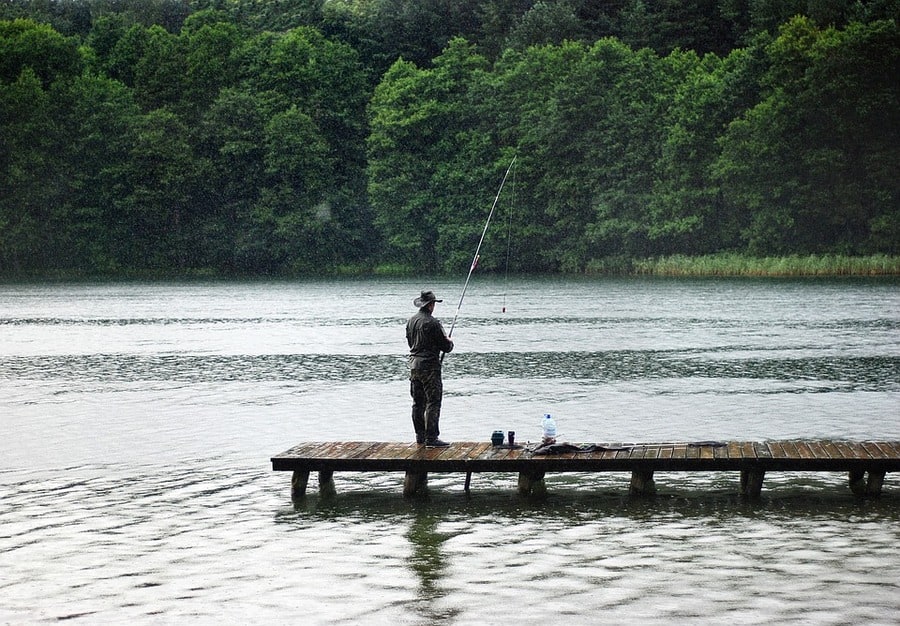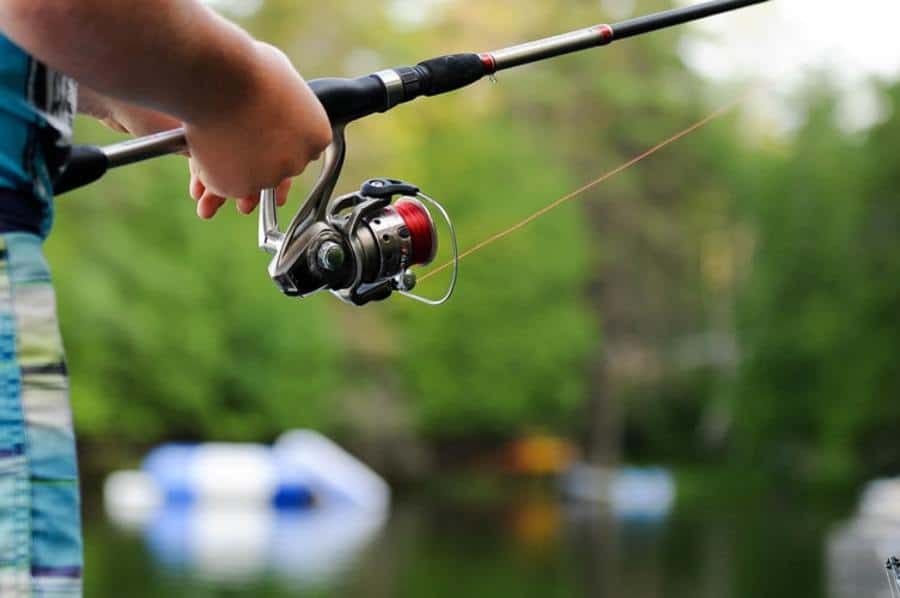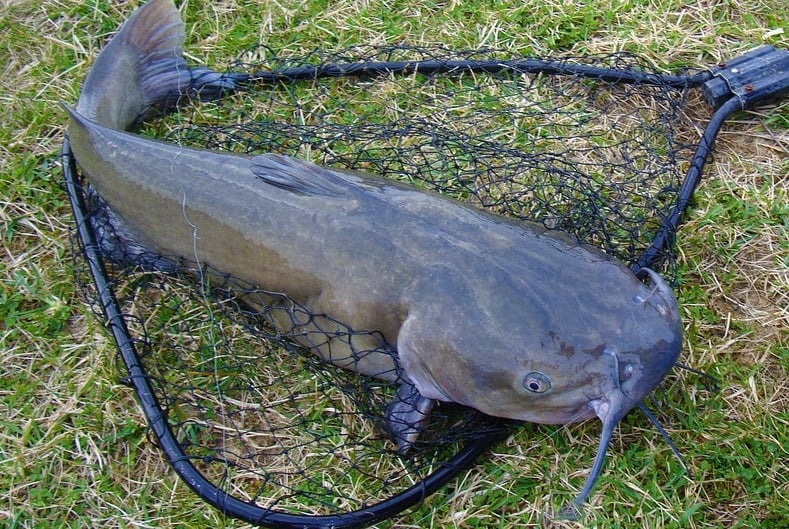Catching Big Catfish: How Rain & Flooding Affects Catfish

Leave a comment after this article and let’s talk more about catfishing. I’d love to read your feedback.
Catfish will bite just about any time of the day and night but many fishermen are curious how catfish react to changes in weather, especially in response to rain. Rain affects air temperature, water temperature, water turbidity, water clarity, nutrient disturbance, and available light among other things. So it seems only natural rain will have an effect on fishing for catfish.
Can you catch catfish in the rain? Rain can often times cause catfish to become more likely to feed and actively search out prey than periods of non-rain.
For different reasons that will be discussed later on, catfish will bite before, during, and after rain events which often leads to good catfish fishing.
In this article, we will discuss the factors that influence catfish feeding, how rain and even snow can affect catfish behavior, and how to approach flooding or muddy water situations.
For a complete gear and tackle recommendation for catfish, check out my recommended catfish gear list which will help you catch more and larger catfish than anyone else.
Do Catfish Bite in the Rain?
What Factors Affect Catfish Feeding Behavior
There are a variety of environmental factors that affect catfish behavior and feeding. Catfish do not live in a bubble. They are constantly interacting with the environment around them, and in turn, the environment is influencing catfish a great deal. The temperature and season affect catfish in a big way.
Catfish are much like people. We don’t like extremes and prefer comfort. When it’s cold out, catfish try to find the warmest water possible, often in the deepest hole in a lake.
They will usually feed during the mid-part of the day when it is warmest out. When it’s hot out, catfish try to stay cool again by heading to the deepest part of the lake and operating mostly at night.
The presence of food influences catfish too. Big catfish will key in on a food source like a school of shad, bluegills, or a clam bed. The presence and absence of food will dictate much of what catfish do on a day-to-day, hour-to-hour basis. Rain and moon phases can also affect catfish feeding and behavior.
Although many catfish are very active at night, they don’t seem to like a full moon. From what I’ve learned, they prefer night to be as dark as possible.
Rain can warm up or cool down the water depending on the season which usually incites a feeding response. Rain and its effect on catfish will be the topic of this article.
Does Rain & Flooding Affect Catfish?

Rain and flooding does affect catfish feeding and behavior. Rain has a tendency to either warm or cool water temperatures down. For example, in the winter when catfish are wanting warmer water, a rainstorm will warm water temperatures.
In fact, catfish will often move to the mouths of streams and rivers where warm water will flow into a lake first. Likewise, during the hot summer, a sudden rainstorm not only lowers the daytime air temperature but also cools down the water as well.
Rain and flooding washes nutrients and food from land into the water. During periods of river flooding, catfish will move to calmer sections of stream where heavy currents and debris won’t affect them.
Often times, they will position themselves in calm water and face the direction of the stronger current to let dead bait be fed to them.
Catfish won’t want to linger in the heavy current for long. In lakes, flooding often opens up new hunting ground and spots where catfish can ambush prey. Fish in shallower water during a flood.
Can You Catch Catfish Before Rain?
Catfish, like many other species of fish, will feed quite heavily before a rainstorm. Fish react strongly to changes in atmospheric pressure and as a storm system approaches, the pressure-change associated will prompt catfish to get out and eat.
Catfish will feed before, during, and after a rain event but before the rain, food sources like shad and bluegills become quite active before rain. This activity in the available food source is what prompts much of a catfish’s pre-rain feeding behavior.
To catch catfish before rain moves in, use shad, bluegills, clam meat, or shiners as bait. Worms and nightcrawlers will work but only for smaller channel cats. Big flatheads and Blue catfish won’t care about worms.
To rig a fish for big flatheads, use a whole live shad or bluegill. For trophy channel cats and blue catfish, they seem to prefer bluegills or shad cut in half since their mouthparts are smaller.
Can You Catch Catfish During Rain?
As rain sets in, catfish will begin to venture out of their deep winter or summer holes and search for food. Rain usually brings warming or cooling of air and water temperatures depending on the season.
During the winter, rain oftentimes means temporary rising water temperatures. This rise in water temperature activates both prey species and predatory responses in many species of fish to include catfish.
During the rain, overhead noise from the rain hitting the surface, water temperature changes, and reduced light visibility makes it difficult for prey species like shad, shiners, and bluegills to orient and detect approaching threats.
Catfish, with their ability to detect food in very low-light conditions, are better suited for these reduced visibility moments than the food they consume. This gives catfish a tactical advantage over many of their favorite foods and incites them to get out and feed.
Can You Catch Catfish After Rain?
Once the rains have stopped, the full effect of the cooling or warming water will be present. Rains will affect water temperature which usually promotes a feeding behavior in most fish to include catfish.
Rain will also have washed nutrients and food into the water. Catfish won’t normally eat food that the rain washed in the water but the stuff they like to eat will.
Shad, bluegills, minnows, shiners, and clams really like this influx of food and nutrients caused by the rain. Feeding baitfish make themselves vulnerable to attack 3which is why catfish love this point of time.
Heavy rains also stir up nutrients and dirt which can make the water muddy, reduce visibility, and raise water levels.
All of these factors make it ideal for catfish, who don’t rely on their vision to hunt, to seek out and consume fish like shad and bluegills which are very reliant upon their vision.
For a complete gear and tackle recommendation for catfish, check out my recommended catfish gear list which will help you catch more and larger catfish than anyone else.
Best Catfish Bait in Rain
Catfish can be caught on a wide range of baits to include nightcrawlers, worms, crayfish, shiners, bluegills, shad, yellow perch, trout, suckers, minnows, grasshoppers, leeches, corn, anchovies, chicken liver, as well as specially designed stink baits marketed at catfish anglers. These baits all can work well on small catfish, especially small channel catfish.
But if you want to catch large blue catfish, channel catfish, and especially large flathead catfish, you need to give them what they are already eating. 9 times out of 10, big catfish are feeding on baitfish.
Shad, herring, alewives, yellow perch, shiners, and bluegills are what we are talking about. The two best big catfish bait in most waterways are shad and bluegills. These two species of bait will catch all three species of catfish but flatheads prefer bluegills whereas channel cats and blue cats prefer shad.
To catch big flatheads in any weather condition, use a living bluegill as bait. Channel cats and blue catfish do really well with cut bluegills but prefer shad cut in half. This is especially true in rain and after rainstorms pass through when catfish are out looking for freshly dead or wounded shad.
For a complete guide to fishing with both of these type of “trophy” catfish baits, check out my articles on using bluegills and shad as catfish bait.
Fishing for Catfish: Rain in Summer
During the summer, catfish are likely trying to find the coolest, most oxygen-rich water available. Typically this will be in deeper water with plenty of food nearby. Catfish will often hunker near the bottom to get as far away from the warm air as possible.
When it rains, air temperatures will decrease and so will water temperatures by both adding cooler water to the lake and air temperature changes. Catfish really seem to respond quite well during the summer to rain in regards to feeding.
Fishing for Catfish: Rain in Winter
Rain has the exact opposite effect often times on water temperature. Typically winter rain has a tendency to warm up the water.
Catfish will rise out of their deep wintering holes and venture higher up into the water column or into surrounding parts of the lake. It should be noted that rain doesn’t necessarily make catfish easier to catch during the winter.
Catfish bogged down in their wintering holes actually makes locating and catching them so much easier. You could every catfish in a corner of a lake in a small hole.
Easy to find and catch. When catfish venture out of the hole, each catfish might be more likely to feed but locating them becomes a whole lot harder.
For a complete how-to guide on fishing for catfish in the winter, you need to read this fantastic article. You will learn how to locate and catch monster winter catfish when no other fishermen are on the water.
Catfish Feeding & High Water
The beauty of high water for catfish is multifaceted. As water levels rise, it stirs up nutrients and dirt off the bottom which muddies the water reducing visibility. When fishing bass and other sight-first fish, reduced visibility usually makes fishing worse.
However, catfish rely more on their sense of feel and smell to find food so the muddy water actually gives them a tactical advantage over most prey.
What rising waters also does is expose more ground to catfish to hunt. Catfish love deep water near an overhand or undercut bank.
As water levels, many of these new spots are available to catfish which attracts both bluegills and catfish to feed on them. If you are fishing for catfish after water levels have risen, fish near the shore in deep pockets which is where many catfish will be.
Catfish Feeding & Muddy Water
As I’ve mentioned previously, catfish use their senses of touch and smell to detect food. Their sense of sight is a secondary means of finding food. Most prey catfish feed on to include shad, bluegills, yellow perch, trout, minnows, shiners, and suckers are much more sight-dominant.
As water visibility is reduced by mud and stirred up nutrients, the dynamic greatly shifts to predators who can find prey without using their eyes.
When the water is muddy, catfish really hold an advantage over most other fish in the water. They can locate their prey and consume them oftentimes before their prey can see them coming. This is also a reason why catfish are so active feeding on poorly moonlit nights.
Catfish Feeding in Flooded Water

Flooding can cause problems for both fish and fishermen. When flooding occurs on a river, heavy debris enters the water column which can pose a danger to fish and boats.
It can also cause a nightmare scenario to fishermen who are fishing with bait as moving debris will wreck your lines, tangle everything up, and push your hooks into snags. Just not a good situation.
Your best bet for fishing for catfish in flooded rivers is to anchor your boat in calm eddies and side tributaries off the main river current. This is the safest place for your boat, your fishing lines, and it is also where catfish and other predatory fish will rest out of the main current.
How Rain at Night Can Affect Catfish Feeding
Rain at night really won’t affect catfish behavior much more than rain at any other time of day generally speaking.
That said, nighttime rain can actually can a cool night cooler which in turn can completely shut down the bite. On the other end of the spectrum, rain and more specifically, rain clouds can block out the moon and corresponding moonlight of a full.
We have learned that for whatever reason, catfish don’t like full moons. A dense rain cloud can turn on a catfish bite really quick on full moon nights when the bite would otherwise be slow.
Can You Catch Catfish When It’s Snowing
Contrary to popular belief, catfish will bite year-round. That means catfish feed during the dead of winter as well. Snow makes fish react just like rain does. During the dead of winter, snow often means slightly warmer temperatures.
Flathead catfish are the most lethargic catfish during the winter but will feed aggressively when the water temps rise. Storm systems that produce snow can cause just enough of a rise in water temperatures to promote feeding.
Blue catfish especially feeding during the winter and snow really makes them feed aggressively. Channel catfish are somewhere in between flatheads and blue catfish for how they feed during the winter, but snow can often be a trigger for them to feed.
Sometimes snow can bring about colder temperatures which can have the opposite effect on catfish feeding. Keep an eye on the temperature changes associated with snow.
Related Questions
Do Catfish Bite When it’s Cloudy?
Cloudy weather really can amp up a catfish’s feeding activity. During the day, clouds reduce visibility giving catfish an advantage over their prey which relies on eyesight. Clouds also lower air temperatures which make catfish feed more. At night, cloud cover can block out moonlight and catfish don’t seem to like eating on full moon nights so a reduction in moonlight should have a net gain for catfish.
Does Rain Affect Bullhead Fishing?
For the most part, rain produces better bullhead fishing. Rain reduces visibility for prey, stirs up nutrients, and lowers water temperatures. Rain also leads to higher water levels which muddies up the water and gives bullhead access to new hunting ground. All-in-all, rain more often than not will improve bullhead feeding activity and make them easier to catch.
For a complete guide on catching bullheads, check out this comprehensive article I wrote.
